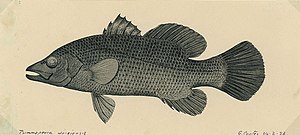Psammoperca waigiensis
| Psammoperca waigiensis | ||||||||||||
|---|---|---|---|---|---|---|---|---|---|---|---|---|

Psammoperca waigiensis |
||||||||||||
| Systematics | ||||||||||||
|
||||||||||||
| Scientific name | ||||||||||||
| Psammoperca waigiensis | ||||||||||||
| ( Cuvier , 1828) |
Psammoperca waigiensis is a predatory fish from the subfamily of giant perch (Latinae) that occurs from the Bay of Bengal north over the Philippines to Japan and east to the north coast of Australia. The fish also go into brackish water , e.g. B. in the Mekong Delta .
features
Psammoperca waigiensis reaches a maximum length of 47 cm, but in most cases is only 20 to 30 cm long. The body is elongated, laterally flattened and of moderate height. As is typical for giant perch, the upper head profile is concave. The snout and jaw are pointed. The jaws reach back to below the front edge of the eyes. On the lower branch of the first gill arch there are 12 to 14 gill rakes . The lower edge of the preoperculum is smooth. At the back corner of the preoperculum there is a large, flat spine. The nostrils on the two sides of the head are wide apart.
The dorsal fin is supported by seven or eight hard rays and 12 to 14 soft rays. It is deeply indented in front of the last and shortest hard jet. The anal fin has three hard rays and 8 or 9 soft rays. The caudal fin is rounded and the bases of the dorsal and anal fin are scaled. The scales of the fish are fixed comb scales. The sideline of the fish extends to the tail fin.
Psammoperca waigiensis is silvery-gray to dark brown in color, but the belly is lighter. The longitudinal rows of scales can be marked by darker, brownish lines, while the fins have no pattern. The eyes of the predatory fish are golden-brown and reflect reddish in the light.
Of Psammoperca Datnioides , the second species of the genus Psammoperca, differs Psammoperca waigiensis by the lighter color ( P. Datnioides is blackish-brown), a higher body (mean body height = 36.7% of the standard length vs. 28.9% of the standard length in P. datnioides ), fewer scales along the lateral line (46–48 vs. 49–54) and fewer scales above and below the lateral line (4½ / 9½ – 10½ vs. 6½ / 10½ – 11½). In Psammoperca waigiensis the jaws reach back to below the anterior edge of the eye, in P. datnioides to behind the middle of the eye.
Way of life
Psammoperca waigiensis lives at depths of 3 to 12 meters in the sea in rock and coral reefs and often near larger algae stocks, e.g. B. from Sargassum . The fish are nocturnal, hide in crevices or under overhangs during the day and hunt small fish and crustaceans at night.
Individual evidence
- ^ A b c d e Kent E. Carpenter, Volker H. Niem: The Living Marine Resources of the Western Central Pacific. Volume 4. Bony fishes part 2 (Mugilidae to Carangidae). Rome, FAO. 1998, ISBN 92-5-104301-9 . Page 2432.
- ↑ a b Psammoperca waigiensis on Fishbase.org (English)
- ↑ Yukio Iwatsuki, Stephen J. Newman, Fumiya Tanaka, Barry C. Russell: Validity of "Psammoperca datnioides" Richardson 1848 and redescriptions of "P. waigiensis "Cuvier in Cuvier & Valenciennes 1828 and" Hypopterus macropterus "(Günther 1859) in the family Latidae (Perciformes) from the Indo-West Pacific. Zootaxa 2018, 4402 (3): 467-486, doi: 10.11646 / zootaxa.4402.3.3